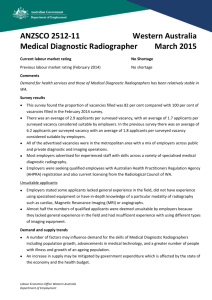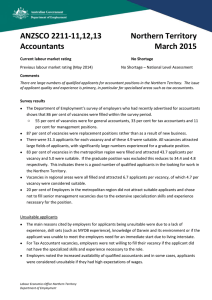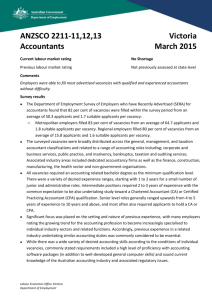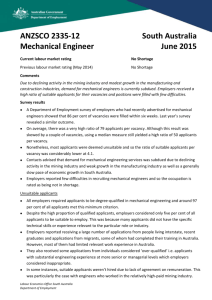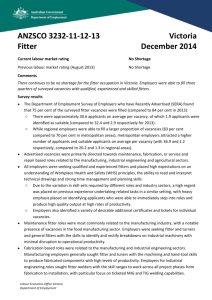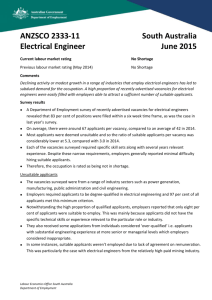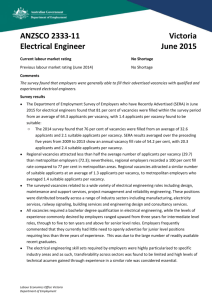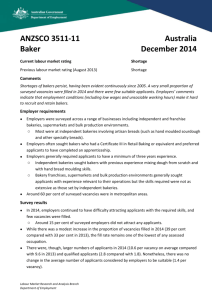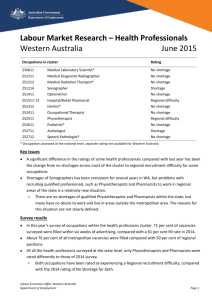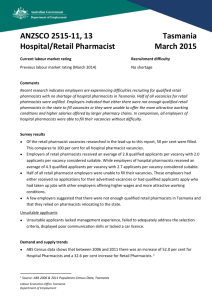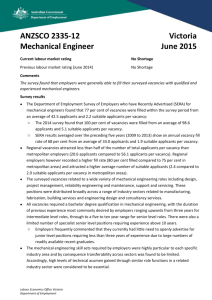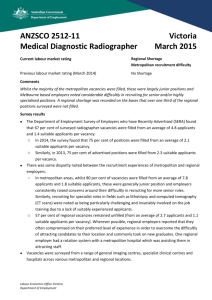Survey results
advertisement
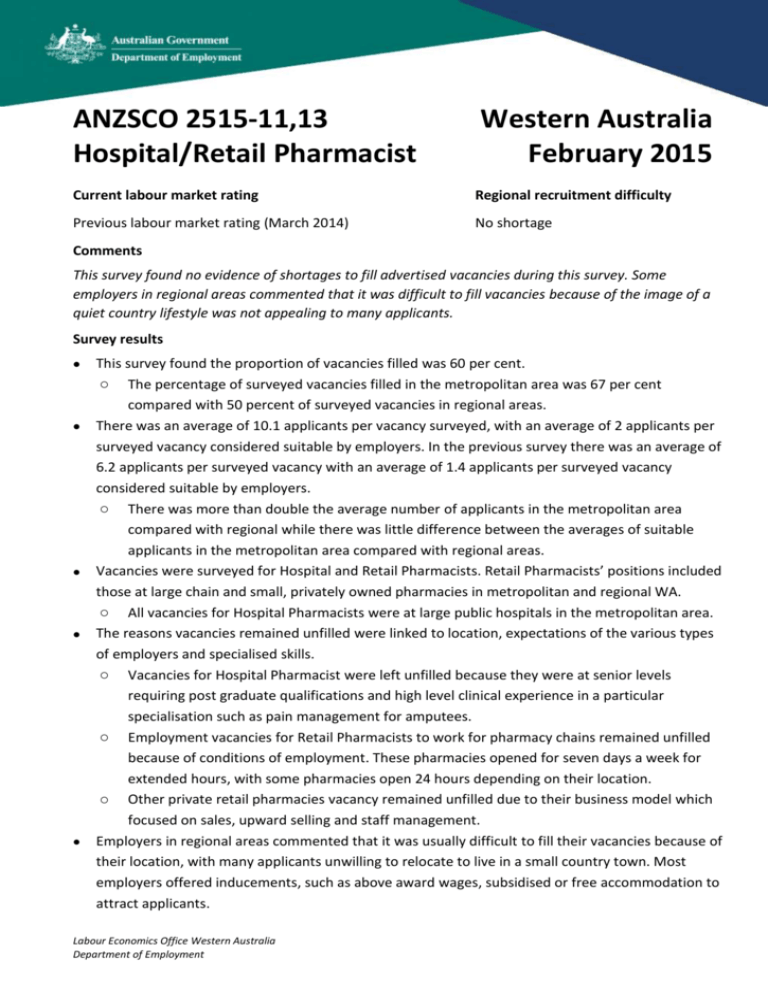
ANZSCO 2515-11,13 Hospital/Retail Pharmacist Western Australia February 2015 Current labour market rating Regional recruitment difficulty Previous labour market rating (March 2014) No shortage Comments This survey found no evidence of shortages to fill advertised vacancies during this survey. Some employers in regional areas commented that it was difficult to fill vacancies because of the image of a quiet country lifestyle was not appealing to many applicants. Survey results This survey found the proportion of vacancies filled was 60 per cent. o The percentage of surveyed vacancies filled in the metropolitan area was 67 per cent compared with 50 percent of surveyed vacancies in regional areas. There was an average of 10.1 applicants per vacancy surveyed, with an average of 2 applicants per surveyed vacancy considered suitable by employers. In the previous survey there was an average of 6.2 applicants per surveyed vacancy with an average of 1.4 applicants per surveyed vacancy considered suitable by employers. o There was more than double the average number of applicants in the metropolitan area compared with regional while there was little difference between the averages of suitable applicants in the metropolitan area compared with regional areas. Vacancies were surveyed for Hospital and Retail Pharmacists. Retail Pharmacists’ positions included those at large chain and small, privately owned pharmacies in metropolitan and regional WA. o All vacancies for Hospital Pharmacists were at large public hospitals in the metropolitan area. The reasons vacancies remained unfilled were linked to location, expectations of the various types of employers and specialised skills. o Vacancies for Hospital Pharmacist were left unfilled because they were at senior levels requiring post graduate qualifications and high level clinical experience in a particular specialisation such as pain management for amputees. o Employment vacancies for Retail Pharmacists to work for pharmacy chains remained unfilled because of conditions of employment. These pharmacies opened for seven days a week for extended hours, with some pharmacies open 24 hours depending on their location. o Other private retail pharmacies vacancy remained unfilled due to their business model which focused on sales, upward selling and staff management. Employers in regional areas commented that it was usually difficult to fill their vacancies because of their location, with many applicants unwilling to relocate to live in a small country town. Most employers offered inducements, such as above award wages, subsidised or free accommodation to attract applicants. Labour Economics Office Western Australia Department of Employment All advertised vacancies required a basic qualification of a bachelor degree in Pharmacy and registration with the Australian Health Practitioner Registration Agency (AHPRA). o There was a preference for Hospital Pharmacists to have post graduate qualifications in clinical pharmacy in a specialised area, such as production of chemotherapy drugs or pain management drug therapy. All employers required additional skills, such as management and administrative skills. Experience with planning and budgeting was also important, with high level communication and interpersonal skills being rated as essential. Unsuitable applicants Overall 56 per cent of qualified applicants were considered unsuitable by employers with the main reason being lack of experience working in either a retail or hospital pharmacy. Lack of management, administrative, communication and people skills were also reasons some applicants were deemed unsuitable by employers. Demand and supply trends Demand for Pharmacists is driven by a variety of factors including: population growth, changes to public health policy and increased awareness of health preventative measures. o At June 2014, WA continued to experience the highest rate of population growth in the nation with a 2.6 per cent increase following a 3.6 per cent growth in the previous year. o The national growth rate for the same period was 1.7 per cent following a 1.8 per cent growth in the previous year1. The WA Health Total Expense Limit for 2014-15 is $8.009 billion and includes key initiatives including: metropolitan and regional infrastructure development; clinical service reconfiguration and ICT development across the state2. AHPRA registration numbers for Pharmacists in WA at March 2015 was 3,101 (62.52% females) an increase of 1.81% 3 when compared with March 2014 registrations of 3,046 (61.42% females)4. Department of Employment data for February 2015 shows the number of vacancies advertised on the internet have remained relatively steady over the past 12 months5. The main supply source of pharmacists in WA is from students who complete a four year Bachelor of Pharmacy degree. o In 2013 the number of course commencements was 75, a decrease of 11.8 per cent from 2012.6 o In 2013 the number of course completions was 56, a decrease of 12.5 per cent from 2012.7 1 ABS Cat. 3101 Australian Demographic Statistics (accessed 21 April 2014) WA Health Funding and Policy Guidelines 2014-15 , Government Western Australia Department of Health 3 AHPRA, Occupational Therapy Board of Australia, Occupational Therapy Registrant Data: March 2015. (Accessed June 16 2015) 4 AHPRA, Occupational Therapy Board of Australia, Occupational Therapy Registrant Data: March 2014. (Accessed June16 2015) 5 Department of Employment, Internet Vacancy Index, February 2015, (raw/12 month moving average) 6 Department of Employment, Higher Education Commencements and Completions, 2013 7 Department of Employment, Higher Education Commencements and Completions, 2013 2 Labour Economics Office Western Australia Department of Employment
